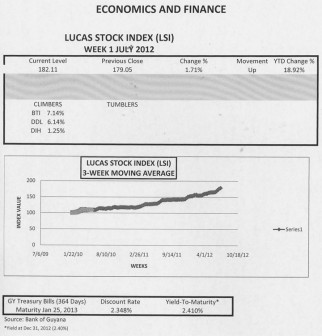By Rawle Lucas
Reluctance
Guyanese are going through a catharsis brought on by the new distribution of political power and a growing sense that their new found influence will eventually break down the stone wall of corruption that was built under the previous administration. For the most part, Guyanese appear satisfied with their new position of influence, even though the administration has not accepted this reality. Quite noticeably, the current administration has been thrown off balance with the need to provide greater accountability to the people through the National Assembly, and to bring under control the corruption, waste and abuse that seem to typify public procurement in Guyana. Apparently, unwilling to adjust to the new reality, it has taken to the courts to see if it could recapture the unfettered power in all branches of government that was lost in the November 2011 elections.

In week one of July 2012, the Lucas Stock Index (LSI) rose 1.71 percent. The lift in the index was provided by the continued strong performance of the stocks of Guyana Bank for Trade and Industry (BTI) which recorded a seven percent gain in value, and that of Demerara Distillers Limited (DDL) with a six percent expansion. Banks DIH (DIH) added to the gain with a one percent increase. In the meanwhile, trades by Caribbean Container Inc (CCI), Demerara Bank Limited (DBL) and Republic Bank Limited (RBL) produced no gain this week. As a result, the LSI continues its upward movement and now exceeds the yield of the 364-day Treasury Bills by more than 16 percentage points.
It can be deduced from the resistance of the administration that the types of change needed to sanitize the economic environment in Guyana will not come easy and were likely to have serious economic consequences. The loss of exclusive control of the reigns of state and the need to share the responsibility of its management with the joint opposition have resulted, no doubt, in the slowing down of the implementation of government projects, and hence the pace of domestic spending. Despite the political uncertainty, investors appear confident, as shown by the performance of the stock market in Guyana in the first-half of the year, that Opposition pressure to clean up the corrupt business environment will win out despite the reluctance of the administration to demolish its edifices. A key player in the performance of the index is the manufacturing sector.
Signs of life
Some evidence of the favourable performance of the market could be gleaned from the stock index produced by this writer. The companies that make up the Lucas Stock Index (LSI) are in the banking and manufacturing industries. Together, these companies have pushed their market value up 16 percent in the first half of the year. The change has been built around shifts in the allocation of resources and the speed with which the resource allocation has taken place. At the end of last year, the dynamics of the stock market suggested that the financial services sector had done much better than the manufacturing sector, even though the latter group has the greater number of companies in the stock index.
The data put out by the administration in its 2012 Budget confirmed that observation. The financial services sector grew by nearly 10 percent while the manufacturing sector averaged a six-percent growth in output. The category referred to as “other manufacturing”, on its own, achieved growth of less than five percent. While the race is not given to the swift, but to those who endureth to the end, the manufacturing sector has begun to push back when measured against the 2011 end of year performance. However, Guyanese will have to wait until the Bureaus of Statistics or the Bank of Guyana puts out a half-year report to find out exactly how well the manufacturing sector has done so far this year. Still, if the performance of the companies in the LSI is anything to go by, the sector continues to show signs of life despite the many challenges that it faces.
Confidence
In spite of the uncertain economic environment stemming from the protracted budget and parliamentary confrontations, investor confidence shows up markedly in the stocks of Banks (DIH), one of the stocks that turned in a lethargic performance last year. Not only has the stock value of DIH outpaced the rest of the stock market, it also outperformed the index itself. From the beginning of January to the end of June 2012, DIH increased its share value by 31 percent while the index grew by an average of about 16 percent. The next best performers were Demerara Tobacco Company (DTC) and Guyana Bank for Trade and Industry (BTI) which both expanded their share value by 27 percent during the period in reference. Demerara Distillers Limited (DDL) also grew at a faster rate. However, Demerara Bank Limited (DBL), a strong performer last year, saw its growth cut in half to 15 percent while Republic Bank Limited (RBL) grew by 11 percent as against the 51 percent recorded for last year. The growth rate of Sterling Products Limited (SPL) also slowed while that of Caribbean Container Inc (CCI) remained constant.
Faster accumulation
The turnaround in the stock value of DIH is a significant development given the relatively unenergetic performance in 2011 when it averaged three percent growth by mid-year and failed to exceed that pace by the end of the year. The faster accumulation of resources also gave manufacturing an increased share of the market value of the index. The financial sector ended last year with 63 percent of the resources and the manufacturing sector ended with 37 percent. As at June 30, manufacturing had increased its share of the index to 39 percent.
The chief contributor to the favourable movement is DIH which share went up two percentage points from 14 percent at December 2011 to 16 percent by the end of June. Close behind was another producer, Demerara Tobacco Company (DTC), whose shares moved up one percentage point from 11 to 12 percent. At the same time, Republic Bank Limited (RBL) saw its portion of the market capitalization decline by two percentage points, suggesting that it was one of those that gave ground to the manufacturing sector. The rapid growth in the market value of DIH is attributed to the solid performance turned in by the company’s core product lines so far this year. Its major product lines of beer and processed foods have done very well for the year and were likely to continue that way for the rest of 2012.
Word of caution
A word of caution is necessary before bringing out the celebratory flags for manufacturing. Despite the speed at which DIH grew and the improvement in market valuation, manufacturing’s share of the market is not where it was this time last year. At the end of June last year, the manufacturing sector had attracted nearly 42 percent of the resources invested in the stock market of Guyana. Comparatively, the sector holds a 39 percent share of the value at this point. The faster growth rate experienced by the manufacturing sector since December, however, augurs well for the sector, and raises hopes that it will continue to grow during the remainder of the year.








